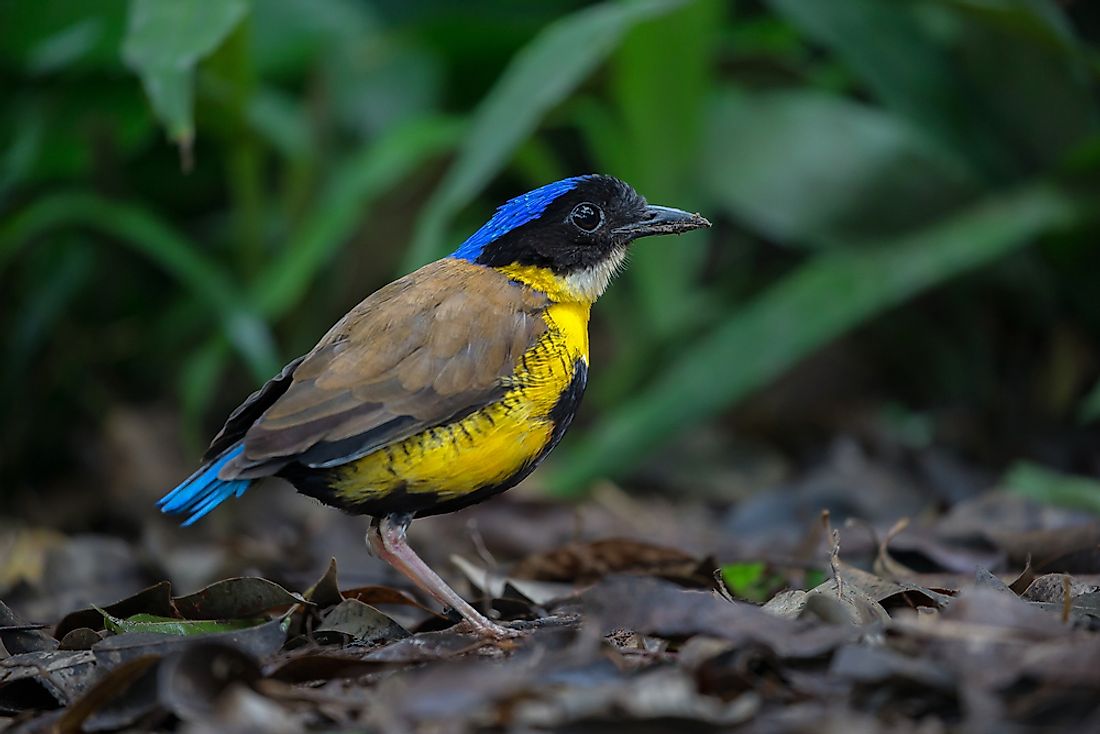Thailand's Most Endangered Birds

Thailand is one of the world's few countries which has lost more than a quarter of its forests to deforestation during urbanization and other projects of modern development. These activities have had a very adverse effect on the ecosystem and as a result, Thailand, which used to be home for over a thousand species of birds and other animals. Deforestation due to agricultural and logging has caused the number of endangered bird species to jump from around 50 species to nearly 180 species as of 1991.
Diverse Natural Habitat
Gurney's Pitta
Gurney's pitta occupies Thailand and can be found eating slugs, insects, and earthworms. The males possess a blue crown white black and yellow underparts, where the female has a brown crown with white underparts. Although, for a period of time, it was believed that the Gurney's pitta was extinct its status is now endangered. At one time, it was believed to be the most rare bird on earth, and was highly sought by birdwatchers. The clearing of natural forests contributes to the loss of its habitat, which threatens the survival of the species.
Wrinkled Hornbill
The wrinkled hornbill is a relatively large bird that has a diet primarily made up of fruit, although it will also eat small animals. Males have bright yellow feathers on the head and bill, although this area is black in female wrinkled hornbills.
White-Eyed River Martin
The white-eyed river martin is a type of swallow that is medium in size of whom little is known about breeding behavior. Trapping and loss of habitat have both contributed to the threatened status of this species. It is endemic to Thailand, and only one of two birds to have this origin. It feeds on insects and has not been officially spotted in Thailand since 1980.
Storm's Stork
The Storm's stork can be found in northern Thailand, although it is estimated that there are no more than 500 storm's storks in the world. Destruction of habitat has been the main contributor to its vitality. The storm's stork feds on small frogs, fish, insect larvae, and occasionally earthworms. The reclusive behavior of this animal has made it difficult to study its behavior.
Conclusion
Thailand is still home to around 10% of the bird species in the world and despite the major deforestation due to increasing population and need for agriculture and farming, it still provides shelter to a large number of birds and a lot of them are endangered due to other factors such as hunting as well. However, conservation activities are underway from both public and private initiative but only time will tell whether the intervention was timely or the increase in the number of endangered species will continue to rise.
Thailand's Most Endangered Birds
| Thailand's Most Endangered Birds | Scientific Name |
|---|---|
| Gurney's Pitta | Hydrornis gurneyi |
| Wrinkled Hornbill | Aceros corrugatus |
| White-Eyed River Martin | Pseudochelidon sirintarae |
| Storm's Stork | Ciconia stormi |
| Black-Faced Spoonbill | Platalea minor |
| House Crow | Corvus splendens |
| Great Stone-Curlew | Esacus recurvirostris |
| White-Rumped Vulture | Gyps bengalensis |
| White-Winged Duck | Cairina scutulata |
| Chestnut-Necklaced Partridge | Arborophila charltonii |
| Crested Fireback | Lophura ignita |
| Nicobar Pigeon | Caloenas nicobarica |
| Malayan Peacock-Pheasant | Polyplectron malacense |
| Chinese Grassbird | Graminicola striatus |
| Scaly-Sided Merganser | Mergus squamatus |











